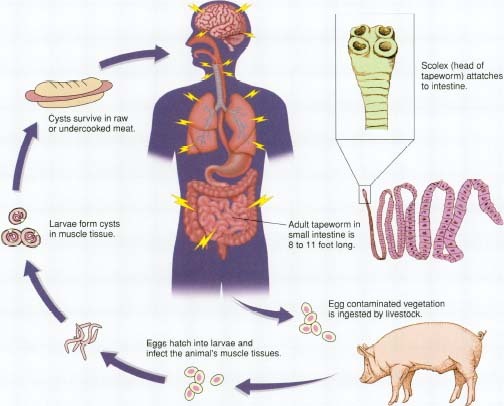It's that time of the year again... the temperature is dropping, pumpkins are being carved, and there's that creepy rustling in the woods as you walk by. All Hallow's Eve fast approaches, and with it come tales of mysterious disappearances, strange sightings, and all kinds of things that go bump in the night.
 So what better parasite to talk about than one that is sure to give you the heebie-jeebies? It's a parasite that you could have for years and not even know it, until one day you're in the hospital with seizures, headaches, nausea, vomiting, or even altered mental status.
So what better parasite to talk about than one that is sure to give you the heebie-jeebies? It's a parasite that you could have for years and not even know it, until one day you're in the hospital with seizures, headaches, nausea, vomiting, or even altered mental status.
Of course, I'm talking about Taenia solium, better known as the Pork Tapeworm.
 The pork tapeworm begins its lifecycle as a little egg being passed in feces by some person who happens to have an adult in their intestines. Once out of the human host, the egg waits to be ingested by its intermediate host - a pig, hence the name.
The pork tapeworm begins its lifecycle as a little egg being passed in feces by some person who happens to have an adult in their intestines. Once out of the human host, the egg waits to be ingested by its intermediate host - a pig, hence the name.
Once in the pig's gut, the egg hatches, and a small, larval oncosphere travels through the intestinal wall and migrates to other parts of the body. Oncosoheres aim for striated muscles, but can end up just about anywhere, including the brain, liver, and other tissues. Once settled, the oncoshperes develop into cysticerci, small, encapsulated cycsts that wait.
 To become an adult, a cysticercus has to be eaten by a human - this happens when people eat infected pork that hasn't been cooked thoroughly. When the cysticercus reaches our guts, it morphs into an adult tapeworm which attaches to the small intestinal lining and begins to grow. Adult worms can get up to 7 meters long - that's over 21 feet. They go about their lives absorbing our nutrients and producing eggs, of which they can produce hundreds of thousands a day.
To become an adult, a cysticercus has to be eaten by a human - this happens when people eat infected pork that hasn't been cooked thoroughly. When the cysticercus reaches our guts, it morphs into an adult tapeworm which attaches to the small intestinal lining and begins to grow. Adult worms can get up to 7 meters long - that's over 21 feet. They go about their lives absorbing our nutrients and producing eggs, of which they can produce hundreds of thousands a day.
Let's be honest - tapeworms are creepy enough when they complete their lifecycle the proper way, ending up in our guts as these long, disgusting leeches stealing our food. But the pork tapeworm can do something much more sinister. If a human ingests the eggs directly, without them going into a pig first, then the cysticerci can develop in our tissues instead. These small cysts can be in our muscles, nervous tissue, or even brain.
 In people, the cysticerci can go unnoticed, as they evade our immune systems for much of their lives. However, after a variable amount of time, the cysticerci start to degenerate, and our immune systems find them. When this occurs, our immune system goes into overdrive, causing the clinical symptoms of cysticercosis. Depending on where the cysticerci are, the signs are different - but they're worst when the little bugs have been living in our brains (see image on the R). The huge immune offensive our bodies launch can lead to all kinds of neurological problems, and even death. You can come down with the clinical symptoms up to ten years after you get infected.
In people, the cysticerci can go unnoticed, as they evade our immune systems for much of their lives. However, after a variable amount of time, the cysticerci start to degenerate, and our immune systems find them. When this occurs, our immune system goes into overdrive, causing the clinical symptoms of cysticercosis. Depending on where the cysticerci are, the signs are different - but they're worst when the little bugs have been living in our brains (see image on the R). The huge immune offensive our bodies launch can lead to all kinds of neurological problems, and even death. You can come down with the clinical symptoms up to ten years after you get infected.
Taenia solium is found all over the world, from China and Southeast Asia to Latin America. In Mexico, the prevalence of cysticercosis is thought to be as high as 4%, but in other Latin American countries it's as high as 20%. Rates reach as high as 10% in African countries and 16% in Madagascar. In the USA, 221 people died from cysticercosis from 1990-2002, even though the parasite is thought to be eradicated from US pig stocks.
So while you'll be afraid of ghosts or goblins this Halloween, perhaps you should be fearing your dinner more. While chowing down on some nice pork tenderloin or some delicious pork chops, remember that this parasite just might be lurking in an undercooked portion. And you thought the swine flu was the worst thing you could get from Mexican pigs!

- Log in to post comments
